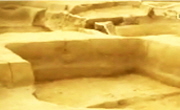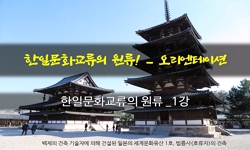In this paper, I reviewed the results of the excavation of Iksan Earthen Fortress and examined the characteristics and meaning of the excavated stamped roof tiles and the date of their use. Like the relationship between the Gwanbuk-ri ruins and Busosa...
http://chineseinput.net/에서 pinyin(병음)방식으로 중국어를 변환할 수 있습니다.
변환된 중국어를 복사하여 사용하시면 됩니다.
- 中文 을 입력하시려면 zhongwen을 입력하시고 space를누르시면됩니다.
- 北京 을 입력하시려면 beijing을 입력하시고 space를 누르시면 됩니다.

익산토성 출토 인각와의 의미와 시기 = The meaning of stamped roof tiles excavated from Iksan Earthen Fortress and their period of use
한글로보기https://www.riss.kr/link?id=A109122523
- 저자
- 발행기관
- 학술지명
- 권호사항
-
발행연도
2024
-
작성언어
-
- 주제어
-
KDC
900
-
등재정보
KCI등재후보
-
자료형태
학술저널
-
수록면
117-137(21쪽)
- 제공처
-
0
상세조회 -
0
다운로드
부가정보
다국어 초록 (Multilingual Abstract)
In this paper, I reviewed the results of the excavation of Iksan Earthen Fortress and examined the characteristics and meaning of the excavated stamped roof tiles and the date of their use. Like the relationship between the Gwanbuk-ri ruins and Busosanseong Fortress in Buyeo, the fortress was operated as a rear fortress or refuge fortress for the Wanggung-ri ruins in Iksan.
Through annual excavations since 1980, Iksan Earthen Fortress was confirmed to be a mixed earthen fortress made of stone and soil, contrary to existing views. The construction method of the fortress wall was confirmed to be excavating the rock layer or filling the slope with soil according to the natural topography, and main pit facilities were confirmed at some points in the male and northern fortress walls, and their use was as support or construction in the process of building the fortress wall.
Although it can be seen as a line, it has been confirmed that it goes inside the castle wall, so the possibility of the existence of antecedent remains can also be considered.
The stamped roof tiles excavated during the excavation of Iksan Earthen Fortress are classified into ‘subu(首府)’ stamped roof tiles, which symbolize the capital and were used in important buildings, ‘obu(五部)’ stamped roof tiles, which are related to the method of organization within the capital city, and ‘kanji(干支)’ stamped roof tiles, which can be dated. do.
The ‘subu(首府)’ stamped roof tile is an stamped roof tile that can only be found in Iksan and other designated areas. Its meaning is thought to be a tile that symbolizes the capital and is used in important buildings in that region. When viewed through 3D modeling results, the ‘subu(首府)’ stamped roof tile represents the repeated useing.
The ‘obu(五部)’ stamped roof tile related to the method of organization within the city walls include ‘sinbu gapwa(申卩甲瓦)’, “hubu eulwa(後卩乙瓦)’ stamped roof tile, ‘sangsu(上氺)’, ‘jeonsu(前氺)’, ‘jungsu(中氺)’, ‘hasu(下氺)’, and ‘husu(後氺)’. The stamped roof tile of the ‘husu(後氺)’ was confirmed. The stamped roof tile, which is a combination of ‘gap(甲)’ and ‘eul(乙)’, is commonly identified in the Iksan and Buyeo regions, and its meaning is thought to be the repair tiles for buildings related to the state or the royal tiles donated by each department for roof tiles needed for construction projects related to the royal family.
Meanwhile, a circular ‘○su(○氺)’ stamped roof tile was newly excavated from Iksan Earthen Fortress, which was a combination of the characters ‘sang(上)’, ‘jeon(前)’, ‘jung(中)·’, ‘ha(下)’, ‘hu(後)’ and ‘su(氺)’. To date, the ‘○su(○氺)’ stamped roof tile has been confirmed only in the Iksan region, and when viewed through the usage of the characters ‘sang(上)’, ‘jeon(前)’, ‘jung(中) ·’, ‘ha(下)’, ‘hu(後)’, it appears to be a new type of ‘obu(五部)’ stamped roof tile. Regarding the background of its appearance, it is thought that it was made for a special purpose different from the nature of the tiles donated by each department for royal-related construction projects, that is, tiles made around construction activities at the time and delivered with taxes.
The ‘kanji(干支)’ stamped roof tiles whose dates can be determined are ‘eulchuk(乙丑)’, ‘jin(辰)’, ‘ohjo(午助),’ ‘sinsa(申斯)’, ‘giyu(己酉)’ stamped roof tiles, which correspond to the years 605 to 650. In the case of stamps whose dates have been confirmed, looking at the fact that they were commonly excavated at the Wanggung-ri ruins, including the Iksan Toseong Fortress, and Mireuksa Temple Site, and the date of construction of the ruins, it can be seen that they were used in the late 6th century to the 7th century, and the main period was the 7th century Baekje. It appears that stamped roof tiles appeared as a result of active construction activities related to Iksan during the reign of King Mu.
동일학술지(권/호) 다른 논문
-
- 호남고고학회
- 이지영
- 2024
- KCI등재후보
-
- 호남고고학회
- 박동범
- 2024
- KCI등재후보
-
- 호남고고학회
- 김은정
- 2024
- KCI등재후보
-
- 호남고고학회
- 천선행
- 2024
- KCI등재후보




 KISS
KISS






